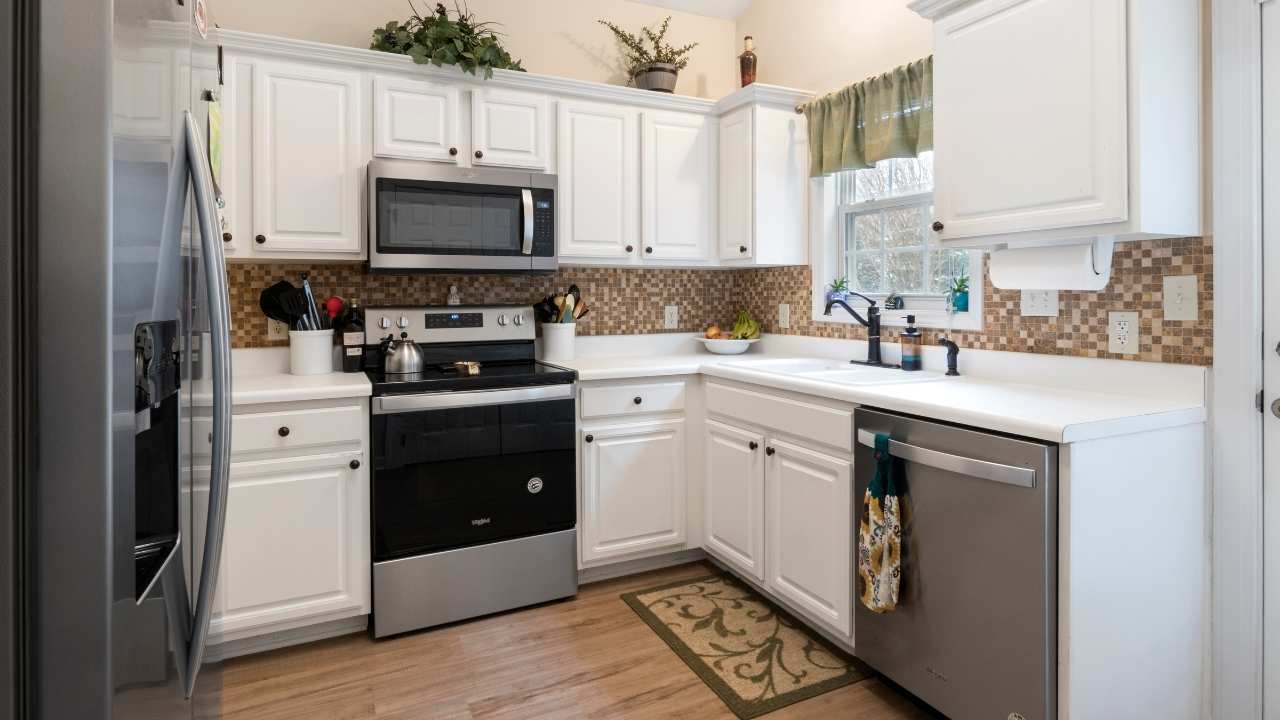Designing a small kitchen isn’t about settling for less — it’s about unlocking more potential from every square inch! With smart planning, bold choices, and a layout that fits your lifestyle, even the most compact kitchens can be transformed into stunning, highly functional spaces. Whether you’re starting from scratch or giving your home a powerful upgrade, choosing the right floor plan is key to success. To dive deeper into the process, explore this comprehensive kitchen remodel guide for expert tips and inspiration.
Working with expert home remodeling services can take your vision even further, turning limitations into limitless possibilities. Ready to rethink your kitchen? Let’s explore the best small kitchen design layout ideas to help you maximize your space and elevate your everyday living.
1. Start with a Clear Vision: Here’s How to Define It in 3 Easy Steps
A great kitchen starts with a clear plan. Before you pick layouts, tiles, or paint colors, you need to get laser-focused on what you truly want and need. Here’s how to define your vision in just three easy steps:
Step 1: Identify the Pain Points
Take a critical look at your current kitchen. What’s frustrating you daily? Is it a lack of counter space? Poor lighting? Awkward traffic flow? Maybe outdated appliances are slowing you down. Make a list of everything that doesn’t work — solving these problems should be your top priority.
Step 2: List Your Must-Haves
Now shift the focus to the future. What features are essential for your new kitchen? Think in terms of both function and comfort: more storage, an island with seating, better lighting, energy-efficient appliances. Knowing your must-haves will help you stay grounded when making future design decisions.
Step 3: Choose a Style That Reflects Your Home
Finally, think about the overall look and feel you want. Should your kitchen be sleek and modern, cozy and rustic, or bright and coastal? The style you pick should connect seamlessly with the rest of your home\u2019s character, creating a sense of flow and harmony throughout.
2. Understand the Main Layout Options: Find the Perfect Fit for Your Space
Choosing the correct kitchen layout isn’t just about looks — it’s the foundation for how your kitchen will function every single day. A smart layout creates a better flow, maximizes storage, and even makes the smallest kitchen feel effortless to use. Let’s break down the top layout options and help you find the one that fits your space and lifestyle perfectly:
Single-Wall Kitchen: Sleek and Streamlined
If space is extremely tight or you’re working with an open floor plan, the single-wall kitchen layout is your best option. All appliances, cabinets, and countertops are lined up neatly against one wall, creating a streamlined, easy-to-navigate setup. It keeps things simple and modern, perfect for studio apartments, lofts, or minimalist homes.
Galley Kitchen: Small Space Powerhouse
Need to maximize every inch? The galley kitchen delivers. Two parallel countertops create a narrow corridor of efficiency, ideal for serious cooking. With storage and appliances on both sides, this layout keeps everything within reach and offers tons of functionality without wasting a step. It’s a favorite for compact homes where cooking is a priority.
L-Shaped Kitchen: Open and Flexible
The L-shaped layout uses two adjoining walls, opening up the rest of the room for movement, dining, or even a small island. It’s perfect if you want your kitchen to flow naturally into other living spaces, creating an open, airy feel. Plus, it’s super flexible — easily adapted to both small and medium-sized homes.
U-Shaped Kitchen: Maximum Efficiency
For those who need lots of storage and a true cooking hub, the U-shaped kitchen delivers. Cabinets and appliances span three walls, surrounding the cook with everything they need. This setup is perfect for keeping separate zones for prepping, cooking, and cleaning, but it does need careful space planning to avoid feeling cramped.
Peninsula Kitchen: The Best of Both Worlds
Think of the peninsula as a flexible extension of a U-shaped or L-shaped kitchen, like an island that’s still attached on one side. It’s a fantastic way to add extra seating, prep space, or storage without requiring a full room remodel. Peninsulas are ideal for small kitchens that crave more function without sacrificing flow.
3. Smart Storage Solutions for Tight Spaces
When it comes to small kitchens, storage isn’t just necessary — it’s everything. Without smart organization, even the most stylish space can quickly feel cramped and chaotic. Luckily, clever design strategies can transform every corner, wall, and surface into hardworking storage without sacrificing style.
The goal is to think vertically, use multifunctional pieces, and make sure that no space is wasted. Even the narrowest gaps and smallest nooks can be turned into practical and accessible storage solutions. Here are some of the most effective ways to maximize storage and keep your kitchen feeling open and uncluttered:
- Install floor-to-ceiling cabinetry.
- Use pull-out pantry shelves.
- Add hooks, rails, and magnetic strips on walls.
- Incorporate hidden storage in bench seating.
- Choose multipurpose islands with drawers and shelving.
A clutter-free kitchen doesn’t just look better — it feels bigger and more welcoming. Every smart storage move you make gives you more freedom to cook, gather, and enjoy your space without constantly searching for what you need.
4. Design Techniques to Make Small Kitchens Feel Bigger
In small kitchens, it’s not just about the square footage — it’s about how big the space feels. Great design can completely transform the perception of size, making even the most compact kitchen seem open, bright, and inviting.
The secret lies in choosing materials, colors, and lighting that visually expand the room. By creating clean lines, seamless transitions, and maximizing light, you can trick the eye into perceiving more space than is there. Small changes here make a huge difference in day-to-day comfort and style.
Here are some of the most effective techniques to open up your kitchen visually:
- Light-colored cabinets and countertops create an airy feel.
- Glossy tiles or mirrored backsplashes reflect light.
- Open shelving instead of upper cabinets reduces visual bulk.
- Under-cabinet lighting eliminates shadows and highlights surfaces. For more ideas on illuminating your space effectively, check out our kitchen lighting guide.
- Consistency in materials and color palettes prevents the space from feeling choppy.
Every choice you make should contribute to a sense of flow and simplicity. When everything feels connected and bright, your kitchen not only looks larger — it feels like a place you want to spend more time in.
5. Combining Dining and Cooking Areas: Smart Solutions for Small Spaces
When space is limited, combining your dining and cooking areas isn’t just practical — it’s essential. The trick is to blend these two functions seamlessly, so the kitchen feels open, social, and efficient without feeling overcrowded.
In a small kitchen, every square inch must work double duty. Choosing the correct design elements lets you maximize functionality without sacrificing comfort or style. Whether you need a casual breakfast spot or a cozy nook for family meals, here are creative ideas for making it happen:
- Extend a countertop or peninsula into a breakfast bar for a casual dining area.
- Install a drop-leaf table that folds away when not in use.
- Opt for slim-profile chairs and stools that tuck neatly under counters.
- Build a compact banquette seating area against an empty wall or corner.
These solutions keep the kitchen open, encourage easy movement, and turn your cooking space into the true heart of the home, even in small square footage. A well-designed eating area adds a warm, welcoming feel that invites conversation, quick meals, and casual entertaining, all without overwhelming the space.
6. Outdoor Kitchen Layout Ideas for Small Spaces
Do you think you need a sprawling backyard to enjoy an outdoor kitchen? Think again. With smart planning and creative layouts, even the smallest patios, balconies, or courtyards can host an incredible cooking space that feels like an extension of your home.
The key is to focus on essentials and layouts that maximize functionality without overwhelming the space. Compact outdoor kitchens prove that great things do come in small packages. Here’s how to make it work:
- Stick to a single-wall layout to keep everything — the grill, sink, fridge, and prep area — aligned and accessible along a single, streamlined surface.
- Opt for an L-shaped layout if you have a corner to work with, creating distinct zones for prepping, cooking, and serving.
When planning, choose durable, weather-resistant materials like stainless steel, stone, and treated wood that can handle the elements with style. Incorporate features like built-in storage under counters, stackable seating, and vertical gardens to add functionality without clutter.
Small outdoor kitchens aren’t just practical—they’re game changers. They extend your living space, create a perfect setting for gatherings, and offer the ultimate summer upgrade, even when square footage is at a premium.
7. Budgeting for a Small Kitchen Remodel: Spend Smart, Save Big
A small kitchen remodel doesn’t always mean a small price tag — but with smart planning, you can make every dollar count. Setting a realistic budget early helps you prioritize what matters most, avoid unexpected costs, and get the best results without overspending.
Here’s what to expect for a typical small kitchen remodel (typically under 100 sq ft):
- Cabinets: $2,000 – $6,000
- Countertops: $1,000 – $3,000
- Appliances: $1,000 – $4,000
- Flooring: $1000 – $3,000
- Labor: $2,000 – $5,000
Where to Save:
- Reface or repaint existing cabinets instead of replacing them.
- Choose cost-effective materials like laminate or butcher block for counters.
- Shop appliance sales or consider lightly used, certified models.
Where to Invest:
- Durable countertops — your kitchen works hard every day.
- Good lighting — it dramatically improves how your kitchen feels and functions.
- Skilled labor — a perfect layout depends on proper installation.
When exploring small kitchen design layout ideas, remember that smart investments today lead to a more beautiful and functional kitchen that stays valuable for years to come.
8. Essential Tips for a Successful Small Kitchen Layout
Building the perfect small kitchen is about making intelligent, smart decisions at every stage. Here’s a quick checklist to keep your project on track and set you up for success:
- Focus on functionality first: Always prioritize workflow and movement over decorative extras.
- Maximize vertical space: Tall cabinets, open shelves, and wall-mounted storage make a huge difference.
- Choose space-saving appliances: Slim-profile and multifunctional models are ideal for compact kitchens.
- Keep the design cohesive: Stick to a consistent color palette and materials to create a more open, unified feel.
- Light it up: Good lighting makes a small kitchen feel bigger, brighter, and more inviting.
Every square inch should work hard and look great. When you balance smart planning with creative design, even the smallest kitchens can feel spacious, stylish, and effortlessly functional. And if you need more room, home additions can offer the perfect opportunity to expand your kitchen space while maintaining your home’s style and flow. With smart upgrades or strategic expansions, you can create a kitchen that’s not only beautiful but truly built for how you live.
Start Your Small Kitchen Remodeling Journey with AP Advanced
Your kitchen may be small, but the possibilities are endless. At AP Advanced, we specialize in designing efficient, stylish spaces that work for you. Visit our Jacksonville showroom to find inspiration, get personalized advice, and start turning your small kitchen dreams into a reality.
Showroom hours
Monday – Friday: 8 a.m. – 5 p.m.
Saturday: 10 a.m. – 5 p.m.
"*" indicates required fields

